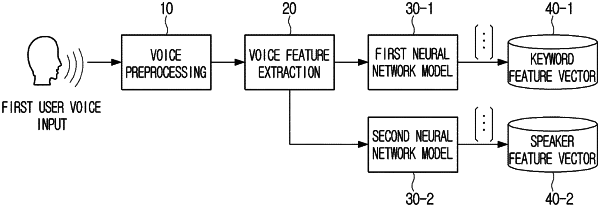| CPC G10L 15/22 (2013.01) [G10L 15/02 (2013.01); G10L 15/26 (2013.01); G10L 2015/223 (2013.01)] | 15 Claims |

|
1. An electronic apparatus comprising:
a microphone;
a communication interface;
a memory configured to store at least one instruction; and
a processor configured to execute the at least one instruction to:
obtain a user voice input for registering a wake-up voice input via the microphone;
input the user voice input into a trained neural network model to obtain a first feature vector corresponding to text included in the user voice input;
receive a verification data set determined based on information related to the text included in the user voice input from an external server via the communication interface;
input a verification voice input included in the verification data set into the trained neural network model to obtain a second feature vector corresponding to the verification voice input; and
identify whether to register the user voice input as the wake-up voice input based on a similarity between the first feature vector and the second feature vector.
|
|
11. A method of controlling an electronic apparatus, the method comprising:
obtaining a user voice input for registering a wake-up voice input;
inputting the user voice input into a trained neural network model to obtain a first feature vector corresponding to text included in the user voice input;
receiving a verification data set determined based on information related to the text included in the user voice input from an external server;
inputting a verification voice input included in the verification data set into the trained neural network model to obtain a second feature vector corresponding to the verification voice input; and
identifying whether to register the user voice input as the wake-up voice input based on a similarity between the first feature vector and the second feature vector.
|